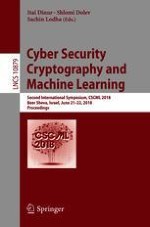2018 | Buch
Cyber Security Cryptography and Machine Learning
Second International Symposium, CSCML 2018, Beer Sheva, Israel, June 21–22, 2018, Proceedings
herausgegeben von: Itai Dinur, Dr. Shlomi Dolev, Sachin Lodha
Verlag: Springer International Publishing
Buchreihe : Lecture Notes in Computer Science
